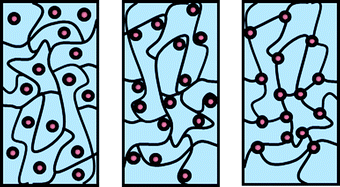Significant advances in the field of responsive hydrogels have been achieved by the combination of soft, gel-based matrices with the unique functions of inorganic or biological nanostructures. Like in many biological tissues, the components of such hybrid materials often have converse, yet complementary properties. The possibility of forming self-assembled and supramolecular morphologies from organic polymers in combination with inorganic nanoparticles or biological motifs is of interest for gels with new response properties. A variety of complex gel structures with unique chemical, physical, and biological properties have been engineered or discovered at the nanoscale. In this review, we highlight recent accomplishments and trends in the field of hybrid polymer hydrogels with a focus on approaches towards soft, yet tough shape-changing and actuating materials. We conclude with an outline on future directions and challenges that have to be faced in the design and application of hybrid hydrogels.

You have access to this article
 Please wait while we load your content...
Something went wrong. Try again?
Please wait while we load your content...
Something went wrong. Try again?


 Please wait while we load your content...
Please wait while we load your content...